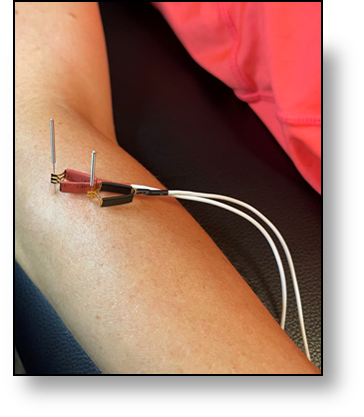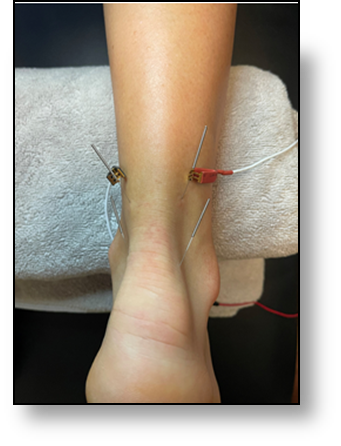09/29/2022
Dry Needling in Physical Therapy
By Tommy Perreault, PT, DPT, OCS, CMTPT/DN, Wentworth-Douglass Hospital Rehabilitation Services
What is Dry Needling?
Dry Needling (DN) is an advanced technique used by healthcare practitioners to treat a variety of painful conditions. It is increasingly used by Physical Therapists, and Occupational Therapists, who routinely encounter pain as a barrier to helping patient’s reach their goals. With dry needling no medication is injected, the needles are simply inserted into the body to treat muscles, and more specifically trigger points, with the goal of increasing blood flow in the muscle and stimulating the nervous system for pain relief. Electrical stimulation is often added to the inserted needles to deliver electrical current for various therapeutic effects.
This is referred to as Intramuscular Electrical Stimulation (IMES), which is a modality used in the treatment of myofascial pain (FIGURE 1). Dry needling is also effective to treat painful tendons, fascia, ligaments and even bones to decrease pain and improve function. Unlike some needles used in medicine that are larger, hollow, and beveled at the end (i.e., hypodermic needles), these are thin diameter, solid-filament needles, like those used in Acupuncture.

Figure 1 -Dry needling to trigger points in the forearm muscles combined with Intramuscular Electrical Stimulation for treating tennis elbow.
Acupuncture is a discipline under the umbrella of Chinese medicine, and unlike dry needling, it is used to treat a wide variety of conditions beyond pain. Both procedures involve needles for the treatment of pain, yet they differ in historical background and underlying theory. Nevertheless, like DN, acupuncture is well supported by scientific evidence to offer unique benefits in the treatment of pain.
Is Dry Needling Effective?
In the last four years alone, more than 15 systematic reviews have provided positive support for the use of dry needling in a variety of conditions including lower back pain, neck pain, myofascial pain, temporomandibular pain, shoulder pain, tension type and cervicogenic-headaches, lateral epicondylalgia, plantar fasciitis, knee osteoarthritis, ankle instability, tendinopathies (FIGURE 2) and more recently spasticity post-stroke. In addition, guidelines from the American College of Physicians recommend that clinicians select needling interventions as one of the initial treatments for chronic lower back pain, before defaulting to drugs or injections. Clinicians who use DN often combine it with other interventions in physical therapy, like exercise, education, soft tissue mobilization, and joint mobilization, among others.
Adding dry needling to other treatments can lead to greater improvement in pain levels and studies have shown that dry needling and stretching have benefits comparable to orthopedic manual therapy for some conditions. Recent evidence from systematic reviews suggests that electrotherapeutic modalities, like IMES, are effective for reducing pain in various chronic pain conditions, including myofascial pain syndrome.
 Figure 2 – Dry needling treatment for Achilles tendinopathy combined with electrical stimulation
Figure 2 – Dry needling treatment for Achilles tendinopathy combined with electrical stimulation
Is Dry Needling safe?
In the hands of well-trained clinicians DN is considered a very safe intervention. By way of example, graduates from Myopain Seminars’ Dry Needling Certification program receive over 80 hours of training and are recognized among the leading providers of DN in the United States. Nearly all negative reactions with dry needling are mild and involve short term bruising or brief pain during treatment. Mild bleeding can occur in some treatments but ceases quickly using light pressure with just a cotton ball, due to the extreme small size and solid nature of the needles. Serious complications resulting from dry needling are extremely rare and are estimated to be as low as 0.04% [9] and 0.1% [10] in recent studies.
Is Dry Needling covered by insurance?
Dry needling is currently billable under some insurance plans, but each provider is different with regards to dry needling coverage. It is always best to check with your current insurance provider to verify coverage for dry needling prior to seeking services. Options are available to pay cash for dry needling when insurance coverage is not provided.
Thomas Perreault, PT, DPT, OCS, CMTPT/DN graduated with a BSc in Kinesiology from The University of Maine and earned his Doctoral Degree in Physical Therapy from Franklin Pierce University .
.
Dr. Perreault is a graduate of the Institute of Orthopedic Manual Therapy Clinical Fellowship in Woburn, Massachusetts and he is a Board Certified Orthopedic Specialist through the American Physical Therapy Association.
Dr. Perreault is currently a Clinical Specialist at Wentworth Douglass Hospital in Dover, New Hampshire
with a focus on Dry Needling for chronic spinal pain, temporomandibular disorders and headache.
He lectures internationally on Dry Needling for Management of Musculoskeletal Disorders. Dr. Perreault is also actively engaged in research and routinely publishes in peer reviewed academic journals.
Tagged In: